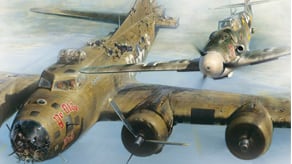CNN's John Blake directs our attention to the tale of Charles Brown and Franz Stigler, American and German pilots in the Second World War, respectively. Brown's plane was badly damaged in a combat run over Germany in December of 1943. While limping home, Brown noticed a German fighter off his wing. With his tail gunner dead, much of his crew wounded, and his plane badly damaged, Brown assumed death was on its way.
But Brown didn't die. Why?
Stigler pressed his hand over the rosary he kept in his flight jacket. He eased his index finger off the trigger. He couldn't shoot. It would be murder.
Stigler wasn't just motivated by vengeance that day. He also lived by a code. He could trace his family's ancestry to knights in 16th century Europe. He had once studied to be a priest.
A German pilot who spared the enemy, though, risked death in Nazi Germany. If someone reported him, he would be executed.
Yet Stigler could also hear the voice of his commanding officer, who once told him:
"You follow the rules of war for you -- not your enemy. You fight by rules to keep your humanity."
Alone with the crippled bomber, Stigler changed his mission. He nodded at the American pilot and began flying in formation so German anti-aircraft gunners on the ground wouldn't shoot down the slow-moving bomber. (The Luftwaffe had B-17s of its own, shot down and rebuilt for secret missions and training.) Stigler escorted the bomber over the North Sea and took one last look at the American pilot. Then he saluted him, peeled his fighter away and returned to Germany.
"Good luck," Stigler said to himself. "You're in God's hands."
Go read the rest at CNN. The pictures gallery is worth the click, and the story ends on a beautiful note.






